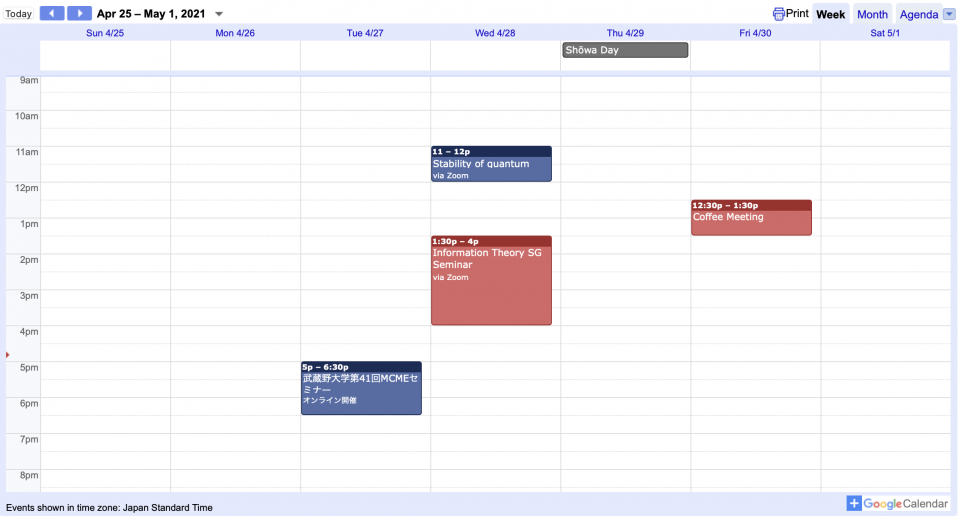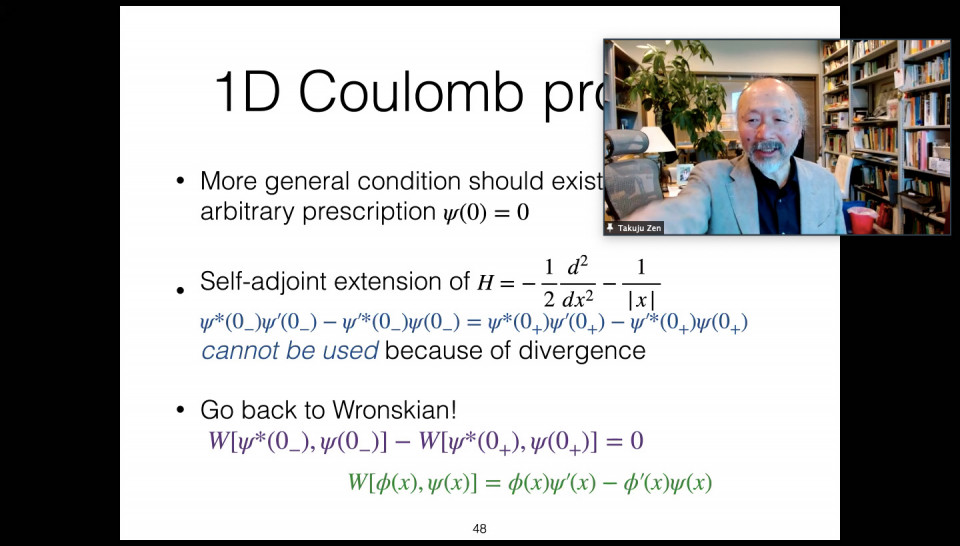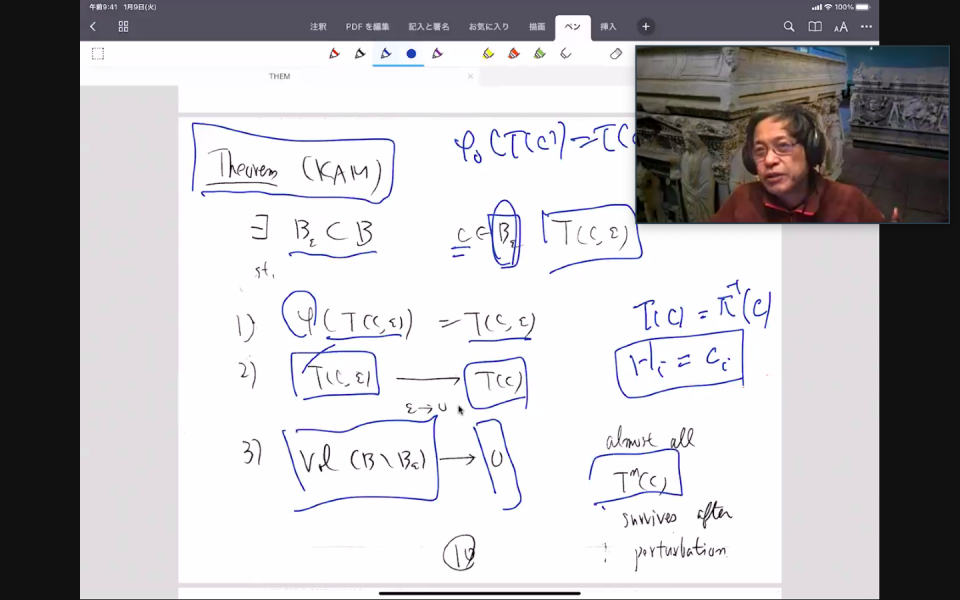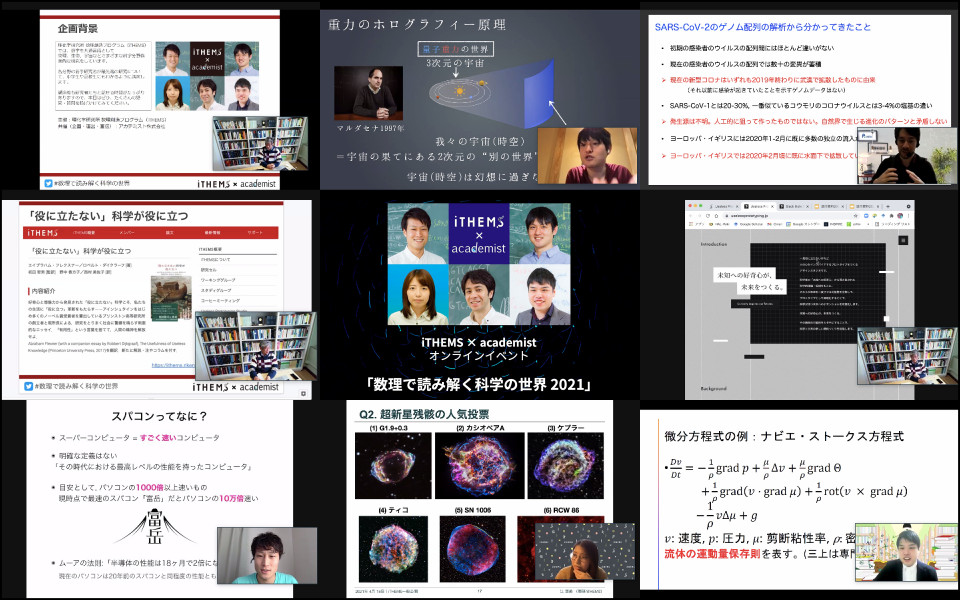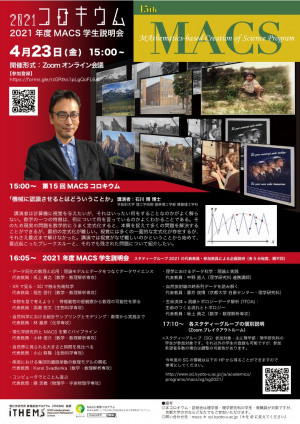Volume 147
Back to Newsletter List
Event Schedule
Events for the 5th week of April 2021
2021-04-22
Wednesday, April 28, 13:30- Information Theory SG Seminar
Thursday, April 29, Shōwa Day (National Holiday!)
Friday, April 30, 12:30- Coffee Meeting
Seminar Report
Math-Phys Joint Seminar by Prof. Takuju Zen on April 13, 2021
2021-04-22
On April 13, Dr. Takuju Zen from Kochi University of Technology gave a talk entitled “Self-adjoint extension in quantum mechanics and non-Rydberg spectra of one-dimensional hydrogen atom” at the iTHEMS Math-Phys joint seminar.
In the first part, he briefly explained the necessity of self-adjointness of operators in quantum mechanics and gave some important examples of such operators. Besides, he mentioned that the self-adjointness of Laplacian is equivalent to flux conservation in one dimension. Finally, he introduced studies of quantum particles on graphs.
In the second part, the speaker discussed one dimensional Coulomb problem. Mainly, he noted that a simple self-adjoint extension of such hamiltonian could not be used. Then he provided a concrete procedure to study the solutions of one dimensional Coulomb problem and explained his interesting results.
Reported by Yukimi Goto
Self-adjoint extension in quantum mechanics and non-Rydberg spectra of one-dimensional hydrogen atom
April 13 (Tue) 16:00 - 18:10, 2021
Seminar Report
iTHEMS Colloquium by Prof. Kenji Fukaya on April 16, 2021
2021-04-21
On April 16, 2021, 13:30-15:00 (JST) 0:30-2:00(EDT), Professor Kenji Fukaya, Simons Center for Geometry and Physics, Stony Brook University, gave a colloquium talk by zoom. The title was "Mirror symmetry and KAM theory". His talk began at the origin of symplectic geometry, namely, the Hamiltonian dynamics. He reviewed completely integrable Hamiltonian systems, where the first integrals define foliation by half dimensional Lagrangian tori with linear flows. The KAM (Kolmogorov-Arnold-Moser) theory describes perturbation of this system and shows that almost all tori persist. Then Professor Fukaya explained the Lagrangian torus fibration found by Strominger-Yau-Zaslow, with the example of the complex projective space. For the complex projective n-space, the image of the moment map is an n-simplex and the regular fibers are Lagrangian n-tori. The inverse image of the boundary of the simplex corresponds to the singular fiber of the holomorphic fibration (the product of homogeneous coordinates) to a disk, By choosing a symplectic form, around the singular fiber of holomorphic fibration, there is defined the monodromy map by using the Hamiltonian flow of the Hamiltonian function that is the absolute value of the fibering. Professor Fukaya told that for this example in dim n = 2, the monodromy near the singular fiber exhibits the KAM theoretic behavior, but in dim n = 3, it is not the case with respect to the Fubini-Study symplectic form. However, he expects it can be the case with respect to the Calabi-Yau Kaehler form. This correspondence between symplectic manifolds (the torus fibration of the complex projective space) and complex manifolds (the holomorphic map to the disk) is an introductory example of the mirror symmetry. His talk might enter much deeper part related with homological mirror symmetry, but he stopped and concluded by saying that the KAM theory explains the transition from completely integrable systems to chaos and it should be possible to find alternative in mirror symmetry or field theory which will explain the transition from stable system to chaos. The talk of Professor Fukaya was really stimulating and his enthusiasm impressed the audience.
Reported by Takashi Tsuboi
Mirror symmetry and KAM theory
April 16 (Fri) 13:30 - 15:00, 2021
Hot Topic
iTHEMS x academist online public event was held on April 18, 2021
2021-04-19
Following last year’s precedent, iTHEMS held an online lecture event for the general public with the help of Academist Inc., on April 18th, 2021. The event was planned as an alternative for the lectures at RIKEN’s annual open house.
The event was started by Kanato Goto with his talk on Blackhole and its information problem. His compelling narrative evoked a lot of questions from high school students; some of them were very sharp.
Next, Jeffery Fawcett talked about genome science. Among other topics he studied, he also mentioned the mutation of COVID-19 virus. During the lunch break, Program Director Hatsuda talked with Mr. Shibato from Academist about related books, the exhibition of Black Hole Recorder at Miraikan, and the attempts with RIKEN SUURI.
In the afternoon, Sugiura-san talked about the supercomputers and the analysis of subatomic physics, followed by Naomi Tsuji's talk on supernovae and their remnants. The talk included several polls from the audience.
Keita Mikami concluded the event with his talk on Mathematics, in particular inequality and differential equations.
All the talks were compered by Ms. Michibayashi from Academist; Her facilitation with a wit kept the talks accessible even to high school students. The event was viewed by as many as more than three hundred audiences at one time.
iTHEMS x academist online open to the public "World of Mathematical Sciences 2021"
April 18 (Sun) 10:00 - 16:30, 2021
Upcoming Events
Colloquium
MACS ColloquiumSupported by iTHEMSSUURI-COOL (Kyoto)
The 15th MACS Colloquium
April 23 (Fri) 15:00 - 17:30, 2021
Hiroshi Ishikawa (Professor, Faculty of Science and Engineering, Waseda University)
15:00- Talk by Prof. Hiroshi Ishikawa
16:05- MACS Student Conference FY2021
Venue: via Zoom
Event Official Language: Japanese
Seminar
Information Theory Seminar
Thermodynamic Uncertainty Relation Connects Physics, Information Science, and Biology
April 28 (Wed) 13:30 - 16:00, 2021
Yoshihiko Hasegawa (Associate Professor, Department of Information and Communication Engineering, The University of Tokyo)
Higher precision demands more resources. Although this fact is widely accepted, it has only recently been theoretically proved. The thermodynamic uncertainty relation serves as a theoretical basis for this notion, and it states that current fluctuations are bounded from below by thermodynamic costs, such as entropy production and dynamical activity. In this seminar, I show a strong connection between the thermodynamic uncertainty relation and information theory by deriving it through information inequality known as a Cramér-Rao bound, which provides the error bound for any statistical estimator. Moreover, by using a quantum Cramér-Rao bound, I derive a quantum extension of thermodynamic uncertainty relation, which holds for general open quantum systems. The thermodynamic uncertainty relation predicts the fundamental limit of biomolecular processes, and thus it can be applied to infer the entropy production, corresponding to the consumption of adenosine triphosphate, of biological systems in the absence of detailed knowledge about them.
*Detailed information about the seminar refer to the email.
Venue: via Zoom
Event Official Language: English
Seminar
DMWG Seminar
Emulation for lensing and clustering observables of the cosmological large-scale structure
May 12 (Wed) 10:00 - 11:00, 2021
Takahiro Nishimichi (Yukawa Institute for Theoretical Physics, Kyoto University)
Recent developments in observational technologies open exciting opportunities to map out the detailed structure of the universe. Remarkably, the unique combination of imaging and spectroscopic galaxy surveys is now becoming well established as a standard analysis methodology for precision cosmology. While the former can access directly the underlying clustering of mass dominated by dark matter projected on the sky through the weak gravitational lensing effect, the latter provides us with the three dimensional map of the structure traced by galaxies. One can mitigate the galaxy-bias uncertainty, which has been the major obstacle for cosmology based on galaxy surveys, by jointly analyzing these effects. We still need, however, a robust and versatile theoretical and statistical framework to interpret these datasets. The Dark Quest project, launched in 2015, is a structure formation simulation campaign precisely
for this purpose. We have developed an emulation tool, dubbed as Dark Emulator, based on a large database of simulated dark matter halos in virtual universes with different cosmologies efficiently sampled in six-dimensional parameter space. Dark Emulator employs a simple machine-learning architecture with Gaussian process at its core. It makes predictions of various statistical measures of dark matter halos, both lensing and clustering observables, for a given cosmological parameters in a few seconds on laptop computers without running a new simulation. This AI-aided tool, once supplemented with recipes for the halo-galaxy connection, is therefore applicable to real-data analyses as the theoretical template, which typically requires hundreds of thousands of function calls in the course of parameter inference. I will introduce this project and report the status of its application to Subaru HSC data.
We are looking forward to seeing you online.
Venue: via Zoom
Event Official Language: English
Paper of the Week
Week 4 of April 2021
2021-04-22
Title: Born-Oppenheimer potential energy surfaces for Kohn-Sham models in the
local density approximation
Author: Yukimi Goto
arXiv: http://arxiv.org/abs/2104.09057v1
Title: Note on the Goldbach Conjecture and Landau-Siegel Zeros
Author: D. A. Goldston, Ade Irma Suriajaya
arXiv: http://arxiv.org/abs/2104.09407v1
If you would like to cancel your subscription or change your email address,
please let us know via our contact form.
Copyright © iTHEMS, RIKEN. All rights reserved.


